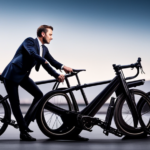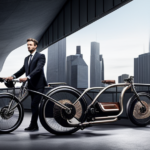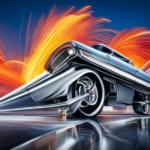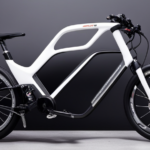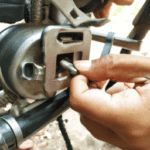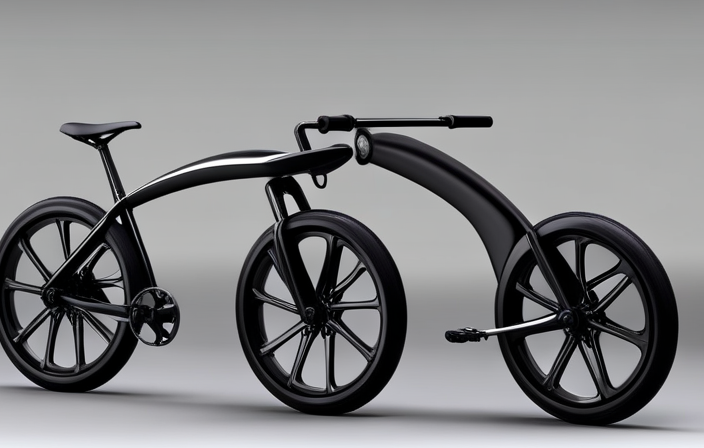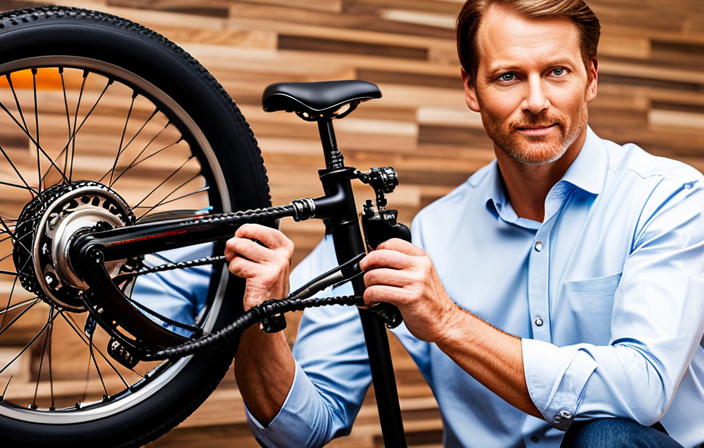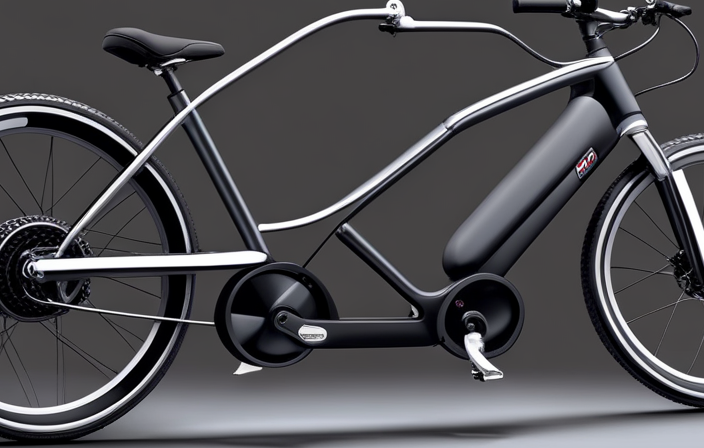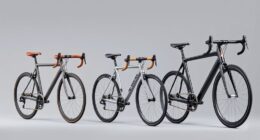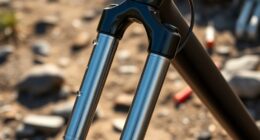Did you know that converting your regular bike into an electric one can be a game-changer? With the right knowledge and tools, you can transform your traditional bike into a motorized, eco-friendly transportation option.
In this article, I will guide you through the step-by-step process of making a motorized bike electric. From assessing compatibility to choosing the perfect conversion kit, we will cover everything you need to know to embark on this innovative journey.
So, let’s get started and unlock the potential of your bike!
Key Takeaways
- Assess bike specifications and condition before choosing an electric conversion kit.
- Gather the necessary tools and materials for the conversion process.
- Follow proper steps to remove existing bike parts before installing the electric motor and battery.
- Ensure safety measures are taken throughout the conversion process and when riding the modified bike.
Assessing Your Bike’s Compatibility
Now, you need to assess if your bike is compatible for an electric conversion. Evaluating compatibility is crucial to ensure a successful transformation.
Start by checking the specifications of your bike. Look for key features such as frame design, wheel size, and weight capacity. Electric conversion kits are designed to fit specific types of bikes, so it’s important to match these specifications.
Additionally, examine the condition of your bike. Make sure the frame is sturdy and free of any damages. Check the brakes, gears, and tires to ensure they are in good working order.
Assess the battery placement options on your bike as well. Some kits require a certain battery configuration, so it’s essential to have the necessary space.
By thoroughly evaluating compatibility and checking specifications, you will be well-prepared to make your bike electric.
Choosing the Right Electric Conversion Kit
To choose the right electric conversion kit for your bike, consider factors such as power output, battery capacity, and compatibility with your current bicycle components.
When choosing the motor, consider the power rating and torque output. A higher power rating will provide a faster and more powerful ride, while torque is important for climbing hills and carrying heavier loads. Also, ensure that the motor is compatible with your bike’s frame and wheel size.
Proper installation is crucial for a successful electric conversion. Carefully follow the manufacturer’s instructions and use the appropriate tools. Ensure all components are securely attached and the wiring is properly connected. Double-check the battery capacity and range to ensure it meets your needs.
Taking the time to choose the right electric conversion kit and installing it correctly will result in a smooth and efficient motorized bike experience.
Gathering the Necessary Tools and Materials
Gathering the necessary tools and materials is essential for a successful conversion. To transform my bike into an electric one, I need to carefully choose the appropriate motor. It should have enough power to propel the bike smoothly and efficiently. I also need to find the right battery, one that can store enough energy to provide a decent range.
Here are the crucial items I need:
- Motor: A powerful and reliable motor is necessary for a smooth and effortless ride.
- Battery: A high-capacity battery is essential to ensure sufficient power for longer rides.
- Controller: This device regulates the flow of electricity from the battery to the motor, allowing for speed control.
- Wiring harness: A set of wires and connectors to connect all the components properly.
- Mounting brackets: These brackets secure the motor and battery to the bike frame, ensuring stability.
By gathering these tools and materials, I can proceed with confidence to the next steps of the conversion process.
Removing the Bike’s Existing Parts
First, you’ll need to start by removing the existing parts from your bike.
To remove the bike’s handlebars, begin by loosening the bolts on the stem using an Allen wrench. Once the bolts are loose, gently wiggle the handlebars back and forth while pulling upwards to release them from the stem. Be careful not to damage any cables or wires connected to the handlebars.
Next, to remove the bike’s pedals, use a pedal wrench to loosen the pedal axle. Turn the wrench counterclockwise to unscrew the pedal from the crank arm. Repeat this process for both pedals. It may require some force to loosen the pedals, so make sure to apply steady pressure while turning the wrench.
Once the pedals are removed, you can proceed to the next step in converting your bike into an electric motorized bike.
Installing the Electric Motor and Battery
Now, it’s time to install the electric motor and battery onto your bike.
To begin, gather all the necessary tools and equipment, including the motorized bike conversion kit. The kit typically includes the motor, battery, controller, throttle, and wiring harness.
Start by mounting the motor onto the bike frame, ensuring it is secure and aligned properly.
Next, attach the battery to a convenient location on the frame, making sure it is well-balanced and won’t interfere with your pedaling.
Connect the motor and battery to the controller using the provided wiring harness, making sure all connections are tight and secure.
Finally, install the throttle onto the handlebars for easy access. Remember to follow the manufacturer’s instructions carefully.
To extend your battery life, consider a few tips.
First, avoid excessive acceleration and braking, as they can drain the battery quickly.
Second, maintain a moderate speed to conserve energy.
Third, keep your tires properly inflated to reduce rolling resistance.
Lastly, use regenerative braking if your kit supports it, as it can help recharge the battery while you ride.
By following these tips and properly installing the motor and battery, you’ll be on your way to enjoying a powerful and efficient motorized bike.
Wiring and Connecting the Components
To optimize the performance of your converted bicycle, it is important to properly wire and connect all the components of the conversion kit. Wiring techniques play a crucial role in ensuring a safe and efficient electrical system for your motorized bike. When connecting the components, it is essential to follow the manufacturer’s instructions and use the appropriate connectors and wires. To help you understand the wiring process, here is a table that provides a visual representation of the connections:
| Component | Wire Color | Connection |
|---|---|---|
| Motor | Red | Positive |
| Black | Negative | |
| Battery | Red | Positive |
| Black | Negative | |
| Controller | Green | Throttle |
| Yellow | Brake |
Troubleshooting tips can also come in handy during the wiring process. If you encounter any issues, check for loose connections, damaged wires, or blown fuses. Additionally, make sure that all the components are compatible and properly grounded. By following these wiring techniques and troubleshooting tips, you can ensure a successful conversion and enjoy a smooth and reliable ride on your electric motorized bike.
Adjusting and Testing the Electric System
You should start by adjusting and testing the electric system to ensure its proper functioning. Testing techniques are crucial to identify any potential issues and ensure that the motorized bike operates smoothly.
First, check all the connections and make sure they are secure. Use a multimeter to measure the voltage and current at various points in the system. This will help you identify any potential wiring or component issues.
Troubleshooting tips include checking the battery’s charge and ensuring that it is properly connected. Additionally, inspect the throttle and controller for any loose connections or damaged wires.
If there are any issues, consult the manufacturer’s instructions or seek professional help. Testing and adjusting the electric system is vital for a safe and efficient motorized bike.
Ensuring Safety Measures
After adjusting and testing the electric system of my motorized bike, it is crucial to ensure safety measures are in place.
Safety should always be a top priority when riding any vehicle, especially one that has been modified. Wearing proper safety gear is of utmost importance to protect oneself from any potential accidents or injuries. This includes a helmet, goggles, gloves, and protective clothing.
Additionally, it is essential to understand and follow local traffic laws to ensure a safe and lawful ride. This means obeying speed limits, signaling properly, and yielding to pedestrians and other vehicles.
By incorporating these safety measures, we can enjoy the benefits of a motorized bike while minimizing the risks and ensuring a safe riding experience.
Maintaining and Troubleshooting Your Motorized Bike
When maintaining and troubleshooting your motorized bike, it’s important to regularly check the battery and wiring connections. This ensures that your electric bike operates smoothly and efficiently.
To troubleshoot battery issues, start by inspecting the battery terminals for any signs of corrosion or loose connections. Clean the terminals if necessary and tighten any loose connections. Next, test the battery voltage using a multimeter to ensure it is within the recommended range. If the voltage is low, recharge the battery or consider replacing it if it no longer holds a charge.
To maintain the electric motor, lubricate the moving parts regularly using a suitable lubricant. Check the motor brushes for wear and replace them if needed. Additionally, inspect the wiring harness for any signs of damage or fraying and repair or replace as necessary.
By following these maintenance and troubleshooting steps, you can keep your motorized bike running smoothly for years to come.
Enjoying Your Electric Bike’s Benefits
Once you start using your e-bike, you’ll quickly discover the numerous benefits it offers. Not only does it provide a convenient and eco-friendly mode of transportation, but it also has several health benefits.
One of the major advantages of commuting on an electric bike is the improvement it brings to your overall fitness. Even though the motor assists you while riding, you still get a great workout. The pedal-assist feature allows you to control the level of effort you put into your ride, making it suitable for all fitness levels.
Additionally, regular cycling can help increase cardiovascular fitness, build muscle strength, and improve joint mobility. So, not only are you saving time and money by using your e-bike for commuting, but you’re also taking a step towards a healthier lifestyle.
Frequently Asked Questions
How long does it typically take to complete the electric conversion process for a motorized bike?
The average conversion time for a motorized bike to electric is typically around 8-10 hours. However, it may vary depending on the complexity of the bike and any common challenges encountered during the process.
Can any type of bike be converted into an electric bike, or are there specific requirements?
Yes, any type of bike can be converted into an electric bike, but there are specific requirements. The electric bike conversion process involves installing a motor, battery, and controller. Converting a bike to electric offers benefits such as increased speed and reduced effort when riding.
Are there any legal regulations or restrictions regarding the use of electric motorized bikes?
There are specific electric bike regulations and licensing requirements that vary by jurisdiction. These regulations may include speed limits, age restrictions, and the need for a driver’s license or registration. It is important to consult local laws before using an electric motorized bike.
How much does an electric conversion kit for a motorized bike typically cost?
An electric conversion kit for a motorized bike typically costs around $500 to $1,000. Converting a motorized bike into an electric bike offers numerous benefits, such as increased efficiency, reduced emissions, and a smoother, quieter ride.
Is it possible to switch back to a non-electric bike after completing the conversion process?
Switching back to a non-electric bike after completing the conversion process is possible. The pros include increased flexibility and reduced maintenance costs. However, the cons include losing the benefits of the electric motor and having to rely solely on pedaling.
Conclusion
In conclusion, converting my bike into an electric motorized machine was a thrilling and rewarding experience. I was amazed at the compatibility of my bike with the electric conversion kit I chose, and the installation process was a breeze with the right tools and materials.
Adjusting and testing the electric system ensured a smooth ride, while implementing safety measures provided peace of mind.
Remember, ‘where there’s a will, there’s a way’ – so go ahead and transform your bike into an electrifying adventure!


